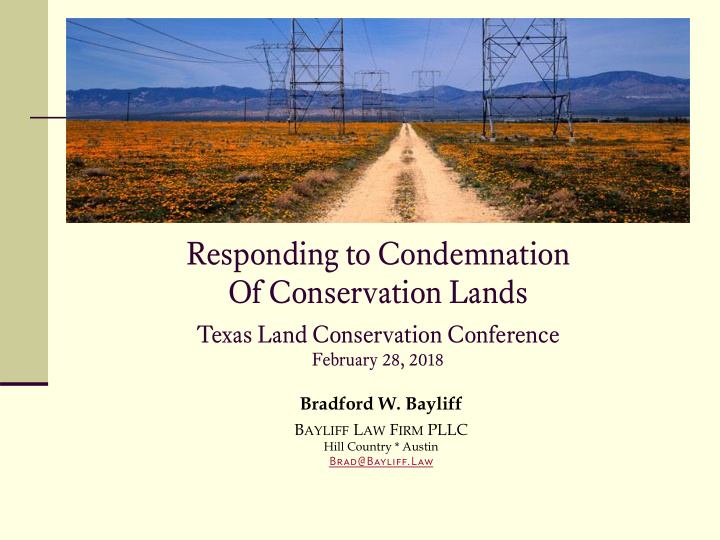



Responding to Condemnation Of Conservation Lands Texas Land Conservation Conference February 28, 2018 Bradford W. Bayliff B AYLIFF L AW F IRM PLLC Hill Country * Austin Brad@Bayliff.Law
Disclaimers The presentation is a general discussion, not legal advice. The information and materials provided may not apply to any specific factual or legal set of circumstances. No attorney-client relationship is formed by this presentation and no such relationship is implied. If you have specific questions about any legal matter consult an attorney. B AYLIFF L AW F IRM PLLC
Outline of presentation Anticipating condemnation What do to before it threatens CEs Effective actions BEFORE a n eminent domain action is filed, but . . . when you know it is coming Eminent domain process Effective actions AFTER an eminent domain action is filed Q&A for all panelists B AYLIFF L AW F IRM PLLC
What is eminent domain? Eminent domain is the power of the sovereign to take property for ‘public use’ without the owner’s consent Eminent domain raises three basic issues: Whether there has been a “taking” of a condemnee’s property interest Whether the property has been taken for a public use. Whether compensation for a proper taking is just Eminent domain power may be delegated to governmental agencies and private entities A utility company must obtain both a construction permit and a right-of-way across each piece of public or private property along the proposed route B AYLIFF L AW F IRM PLLC
What is a utility easement? An easement that gives a utility the right to use and access property for electric, gas, sewer, or water lines It is attached to the property deed so it passes on even when the property is transferred or sold The utility has the right to use the land, but it does not own the land There may be restrictions on the landowner’s land use in an area covered by a utility easement B AYLIFF L AW F IRM PLLC
Anticipating condemnation Before your CE is threatened. Include condemnation provisions in your CEs CVs - Consider open space, scenic, aesthetic and view protections, fragmentation Notice from landowner to LT LT share of condemnation award Include condemnation Qs in annual monitoring Develop community network Nearby landowners Area Realtors Interested volunteers Register with the National Conservation Easement Database (NCED) B AYLIFF L AW F IRM PLLC
NCED United States data depiction B AYLIFF L AW F IRM PLLC
NCED Texas data depiction B AYLIFF L AW F IRM PLLC
Why register with the NCED? There is no requirement that federal or Texas energy planners consider conservation easements or land trust preserves when siting new transmission facilities There also is no requirement that land trusts be allowed a voice in the planning process Reliable data about protected lands and their locations is essential to good planning and policy-making Complete/accurate data improves decision makers’ knowledge Significant public investments have been made in the federal, state and local programs that encourage and incentivize this conservation. We must make sure that our energy policies recognize the public’s stake in lands protected by conservation easements and aim to avoid all unnecessary impacts on these lands. B AYLIFF L AW F IRM PLLC
Effective actions BEFORE an eminent domain action is filed…but when you know it is coming Get involved early Notify funders promptly Assess impact of condemnation on conservation values Appoint a point person or committee Consider hiring an eminent domain attorney B AYLIFF L AW F IRM PLLC
Eminent domain process Process is focused on the landowner Inject the LT into the negotiations The LT’s interests may not be aligned with the landowner Retain an appraiser with eminent domain experience The eminent domain appraisal focuses on: The value of the easement and Damage to the remainder May value each property interest separately Consider options instead of money Your CE will control, though Keep the landowner involved and informed Keep the LT board informed B AYLIFF L AW F IRM PLLC
Responding to an eminent domain action Read the Texas Landowner’s Bill of Rights https://www.texasattorneygeneral.gov/agency/Landowners_billofrights.pdf Landowner and the LT are entitled to compensation Condemnation is only for a public use Utility notifies the landowner it wants to take property Utility provides a written appraisal detailing the adequate compensation it owes you Utility must make a bona fide offer Retain an eminent domain attorney By focusing on a practice area, the attorney can become more competent, experienced, and proficient Learn and understand the process of eminent domain Offer from the utility Court-appointed panel of three special commissioners determines value Either side may appeal to judge or jury trial B AYLIFF L AW F IRM PLLC
Effective actions After an eminent domain action is filed Mary Anne – Public influence, members, coalitions, PR Existing laws and planning processes to oppose Document importance of CE lands that could be affected Continue dialog with the utility and its consultant B AYLIFF L AW F IRM PLLC
Questions for all panelists What is the most important “take away” from this session? There is a process in place – it guides the results No silver bullet will stop the project or route it away from CEs Get what you can but avoid damaging relationship with landowners What is the biggest mistake landowners/LTs can make? Not getting involved and participating fully Any mechanisms to steer utilities away from CEs? Need improvements to statutes, PUC’s rules, and utility company policies – ask for consideration of CEs Register in the National Conservation Easement Database B AYLIFF L AW F IRM PLLC
Bradford W. Bayliff B AYLIFF L AW F IRM PLLC Capitol Hill Country 111 Congress Ave., Ste. 400 420 Crosswind Drive Austin, Texas 78701 Blanco, Texas 78606 (512) 480-9900 Brad@Bayliff.Law
Recommend
More recommend